|
Utilitarian Beauty. |
|
Access Covers
Look down and see where you are. |
|
~ |

Access, manhole, or utility covers, call them what you will...Japan has a much overlooked art form in plain sight and part of daily life. These massive, round or rectangular wonders let the casual observers know where they are as well as the local claim to fame. Each portal to the engineering business below is actually an invitation to an ironcast daydream. In the mode of bird watching, one can note the edging pattern, the colors, if any, the presence or absence of script-English or Japanese, indications of function, keyhole shapes, overall statement, and artful detail. Is the image realistic or abstract? What story is told? Is nature, mythology, local scenery or history, or a traditional product celebrated? Covers are rarely colored. This one is from the hoary Sumoto covered shopping mall in the capital village of Awaji Island. No matter the time of year, it promises the island's Spring joy of massive drifts of daffodills and narcissus and imminent release from drab winter's chill. The hiragana says "Sumoto O-sui." The Honorable Water of Sumoto. |
Access Covers
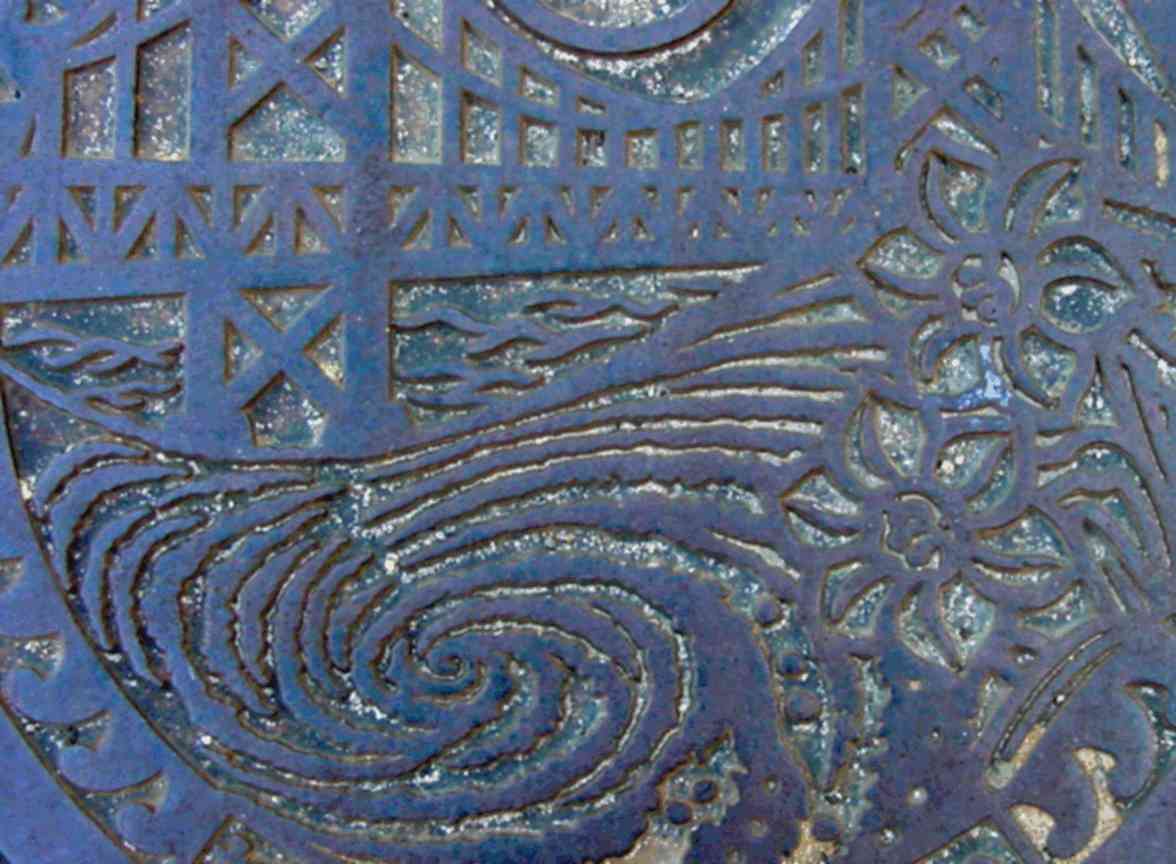
Detail of cover from Nushima, a tiny island off Awaji, a larger island, offshore between Shikoku and Hyogo-ken's cities of Kobe and Osaka. Shows the famous naruto giant whirlpools that form between Awaji and nearby Shikoku. The straits are narrow and deep, and tidal waters rushing in and out interact to form spectacular spirals of water visible from the shores, and to boatloads of terrified tourists. |
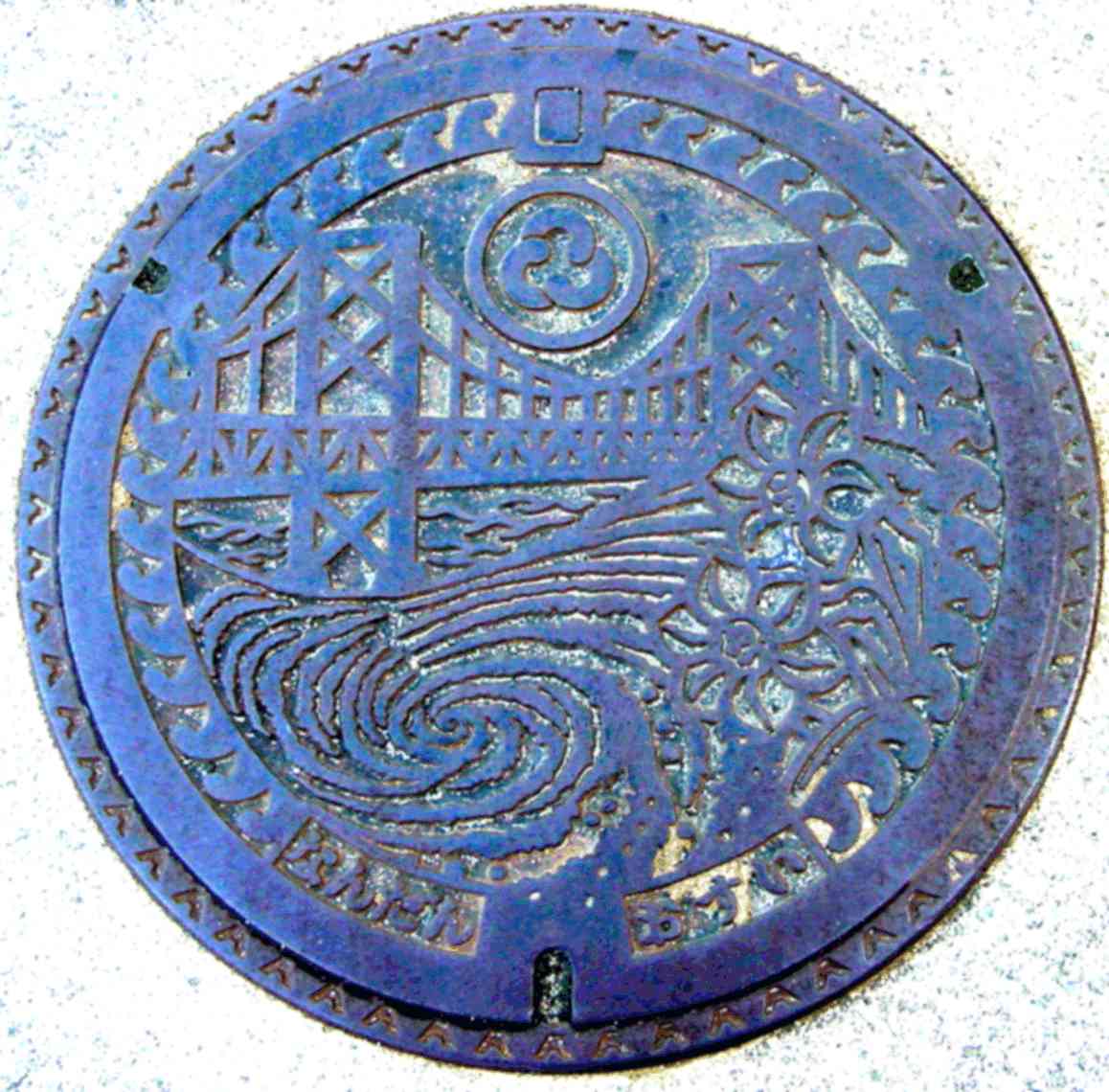
Where is Nushima? It's a tiny island off Awaji, a larger island, offshore between Shikoku and Hyogo-ken's cities of Kobe and Osaka. Only 300 people live there. The combined school of 1st-8th graders totals 50 kids. Almost everyone is very old. The main and only industries are fishing and putting up tourists. This island brought to my attention the lovely individuality of the hundreds of smaller islands that make up Japan. Visit any of them if you have the chance. This cover shows the very large suspension bridge between Awaji-shima and Shikoku, the whirlpools overlooked by foregrounded narcissus flowers. The border is a 'V' shape, and an inner ring may be ocean waves. The circle with three commas forms both the sun and is a common (sorry!) tri-comma of three "dama: ancient symbols of connection to guardian spirits and much more. The hiragana says "nandan osui, or "xxx honorable-water." Three keyholes. |
||||||||||
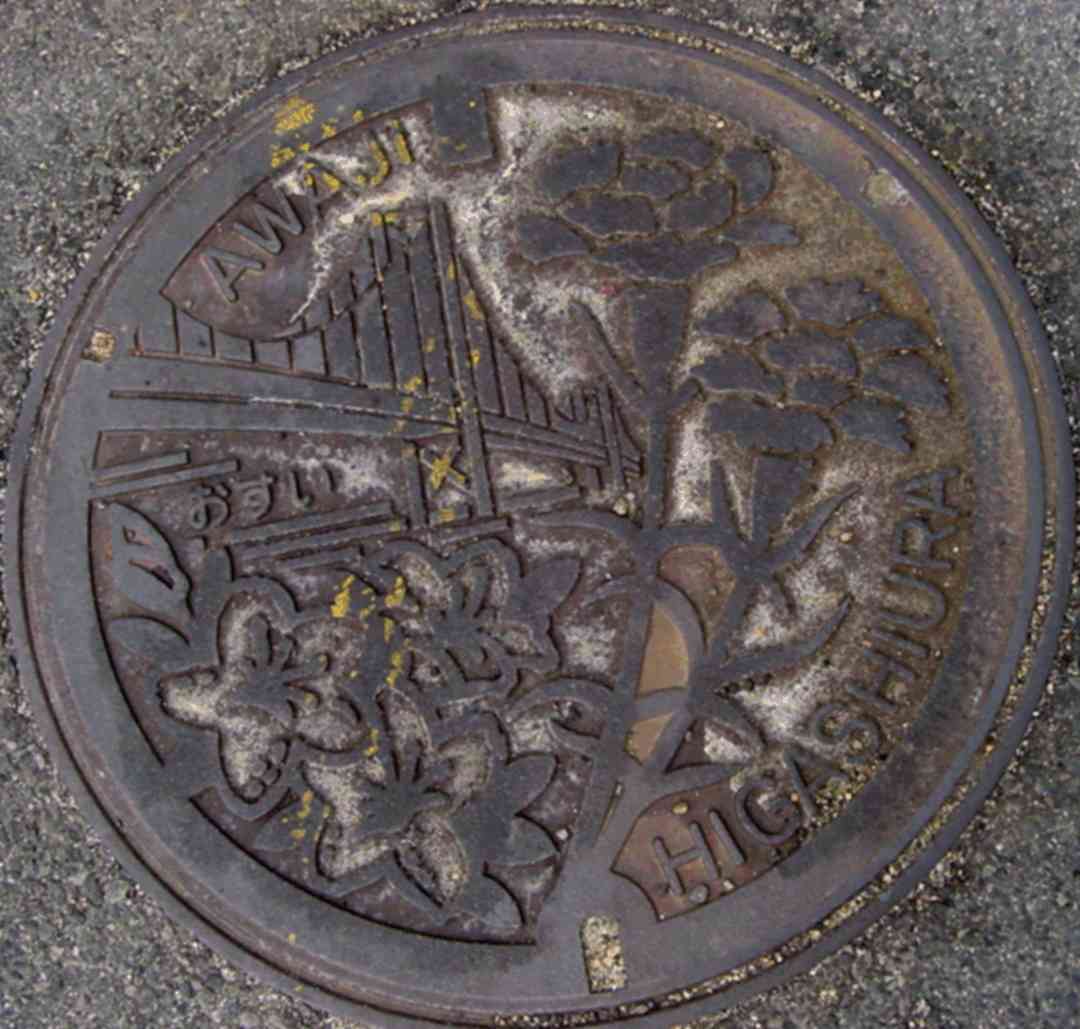
Text in English says "Awaji Higashiura." Awaji the island and Higashiura (Eastern Backside or Tail End [of the island]). OSUI(water) in hiragana Details: the big bridge to Kobe/Osaka in the background. Dianthus and azaleas flowers foregrounded. Plain rim border. My question: Why, in this little backwater hamlet, are the place names in English? |
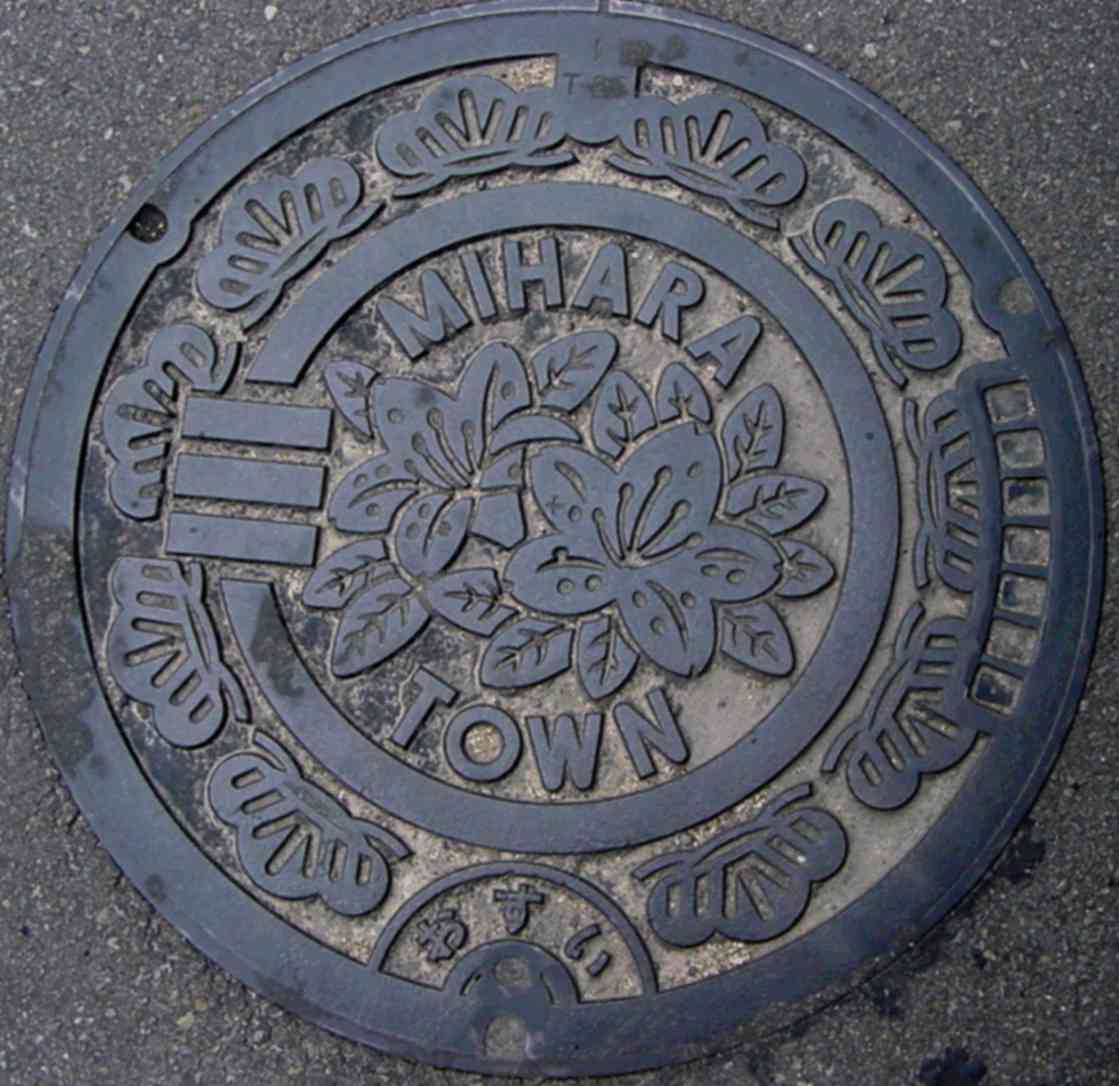
As populations shrink, and economies contract, bureaucrats combine several named villages, then add the highly redundent "town" to the winning name. Mihara survived the name contest, and now awkwardly casts itself as "Mihara Town." In English, no less.Details: Azalea flowers and leaves, and surrounding inner border of pine foliage (longevity and perhaps a nod to the local puppet theatre. The three lines are the Japanese number "3" or "Mi" for "Mihara." Nifty! Hiragana script says "O-sui" or "Honorable Water." On the right edge, seven rectangles with indeciferable English letters. Plain rim border.Three keyholes. |
||||||||||

Tsuna and OSUI(water) in hiragana. On Awaji island. Tsuna is a little coastal hamlet just north of the capital city of Sumoto. Beautifully detailed stem of two Dianthus flowers and bud. Plain outer rim. Small cartoonish flowers along the inner rim. One keyhole and several nocks. |

A lighthearted scattering of Tiger Lily flowers . Six circles or rings. OSUI(water). Plain rim. May be from Awaji, not sure. one keyhole. |
||||||||||
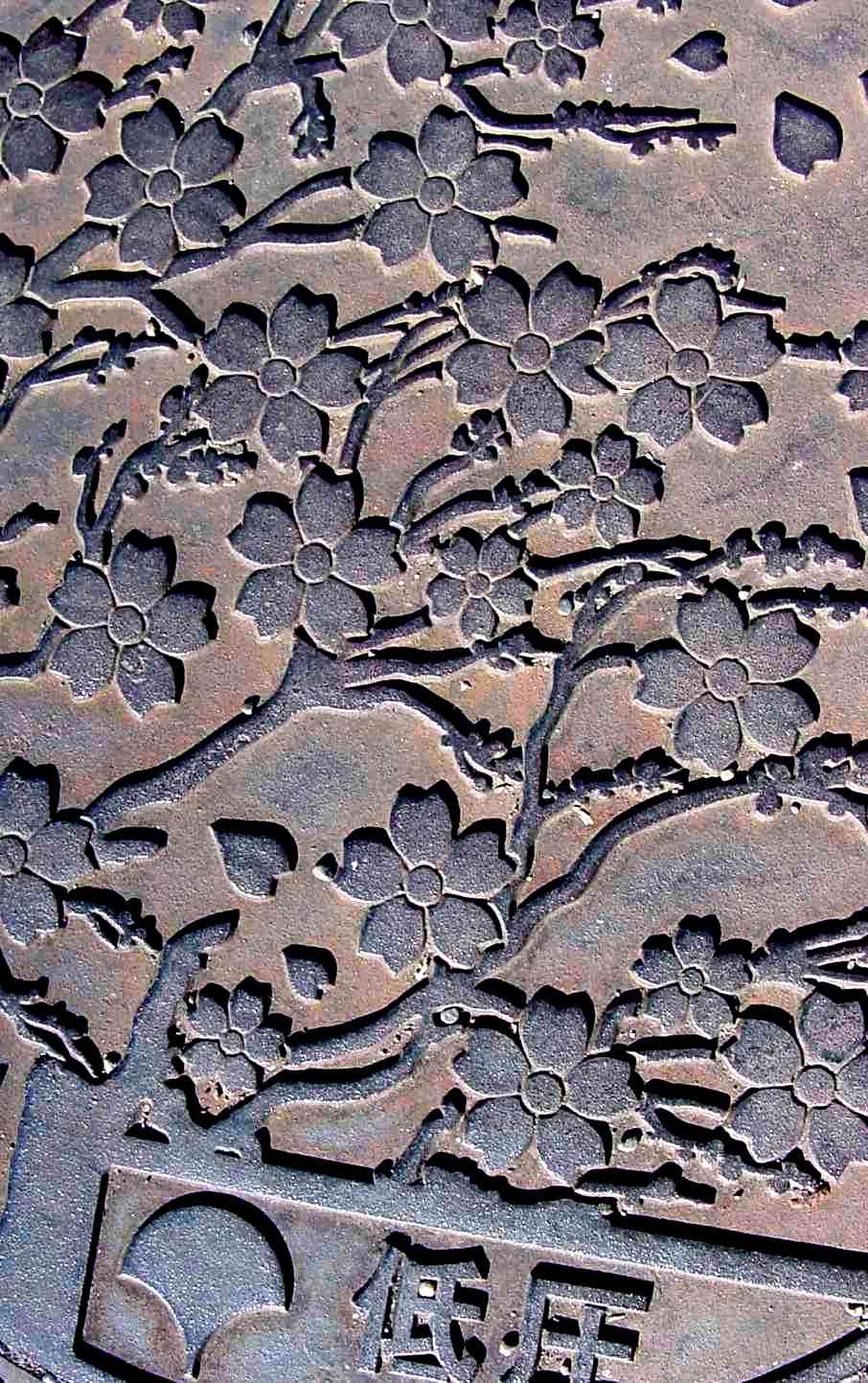
Ueno Koen (park) in Tokyo has long been famed for the massive sakura cherry blossom celebrations. This delicate and detailed artistic rendition may be from a ukiyo-e woodblock print. |

Ueno Koen. A standard trope of poetry and painting, the sakura blooms briefly, then scatters to the winds. Here, the petals swirl within the simple circular border. No keyhole, but two rounded rectangles. The triangular Ginko tree leaf is a symbol of Tokyo in general. The kanji says tei atsu, "low pressure, low voltage." |
||||||||||

Enoshima wisteria. The circle in the middle has the kanji for "Water Collection." A beautifully detailed rendition of wisteria leaves and flowers. Plain border. One main and two minor rim keyholes, and two intake holes. Plain rim border. |

Enoshima? A study in ambiguity. Where's north? Are those flowers camellias, cherry, or plum blossoms? Waterwaves are interspersed with diamond shapes, meaning unclear. One major interior keyhole. Three keyholes on the plain rim. |
||||||||||

The illustrious seaside town of Hayama, home of wealthy expats, artists, surfers, yatchers, and the Imperial Family's vacation compound. It's about an hour south of Tokyo, and is another hybridized town from six villages. Details: "Hayama" and "o-sui" (venerable water), in hiragana. Motifs: single sail yatch on the water, azalea flowers, a magpie perched on three willow branches, and pine clumps. Appears to be access cover number 60. Plain rim and one keyhole. |
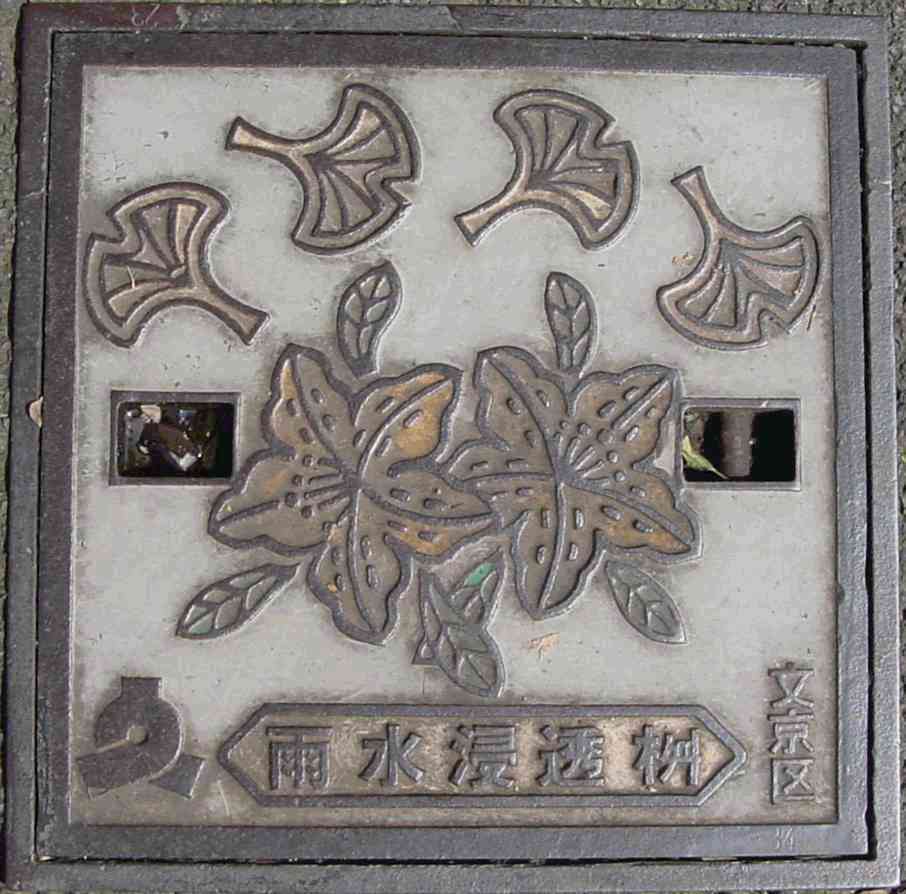
In Bunkyo-ku, just north of Chiyoda-ku, the center of Tokyo, the streets near Myogadani sport this cheerful mark, signifying that rain water is collected below as runoff and held belowground for future recycling, instead of flooding the Sumida River. My informant was quite proud of this. Features: Azalea flowers and leaves, and Ginko leaves, with fading yellow paint. Also, the Bunkyo-ku loopy mark, alongwith "rain water collection" and "Bukyo-ku" in kanji. Plain border. Two keyholes. |
||||||||||
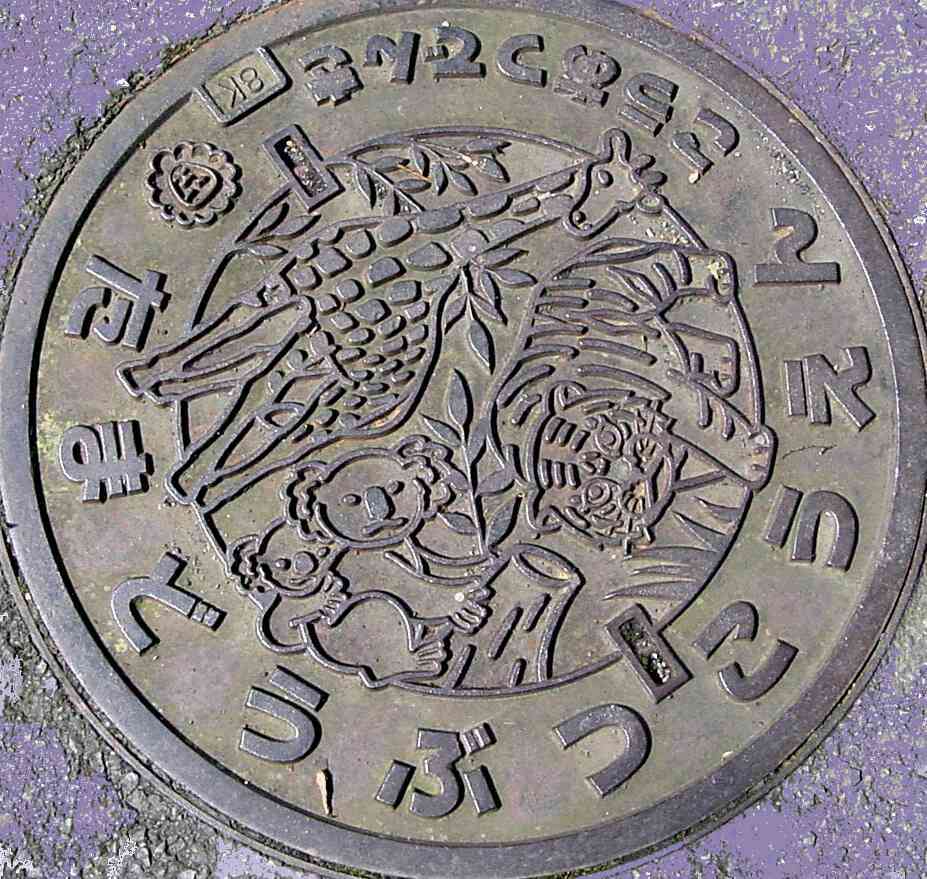
On a blistering hot summer day, I visited Tama Zoo...and lasted about 20 minutes before crawling out of there, utterly defeated by the endless walking, the waves of heat off the black asphalt, the unavoidable stench of many large animals likewise struck immobile by the African-like temperatures...highly recommended for cooler months. Blinded by sweat, I managed to snap this shot of the ubiquitous Tama Zoo access covers. Featured: a tiger, a giraffe, mother and baby koala, leaves and grasses; a lions' head on the outer perimeter. Katakana: Tamadoubutsu kouen (Tama Zoo Park); Kouotsudenki (...electric). 8K means there are 8,000 of these zoo? No paint. Plain border. Two keyholes. |

Kameido go-en. Details: Four strands of unidentified blossoms and two sides referencing Japan's five-yen coin, which is called "go-en, a homophone for 'karma.' Four kanji for "Water Collection" and a single kanji for bun, "literature." |

Kameido turtle. Kame ido means "turtle well." Turtles are symbols of longevity, and there must be many living here as it is a rather low, marshy area originally. In the large ponds, turtles abound, but the single-tailed kind, not this triple paintbrush variety. |
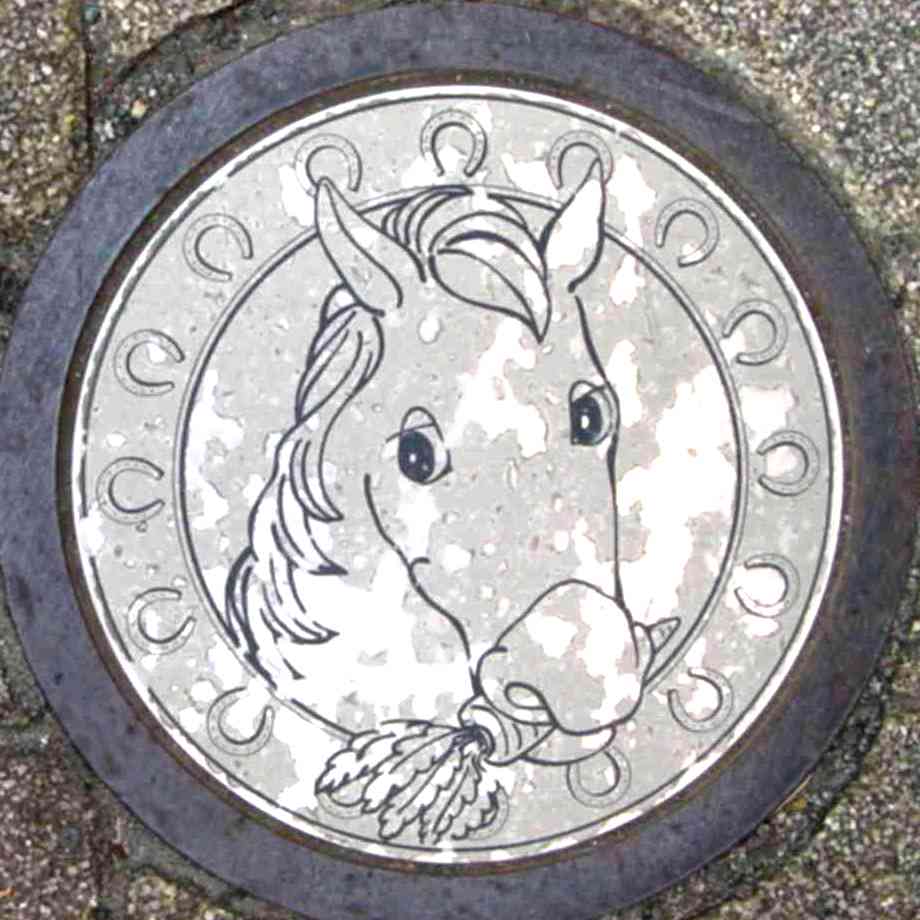
Most streets in Tokyo are nameless. However, I live just off of "Basha-dori" or "Horsedrawn Carriage Street." It's a remarkable street, arrow-straight, and full of iconography, including this cartoony horse munching on a carrot. Peripheral border of 14 horseshoes (should that be 12, or 16?). Thick, plain border. Found only on my "Ba-sha" street! |
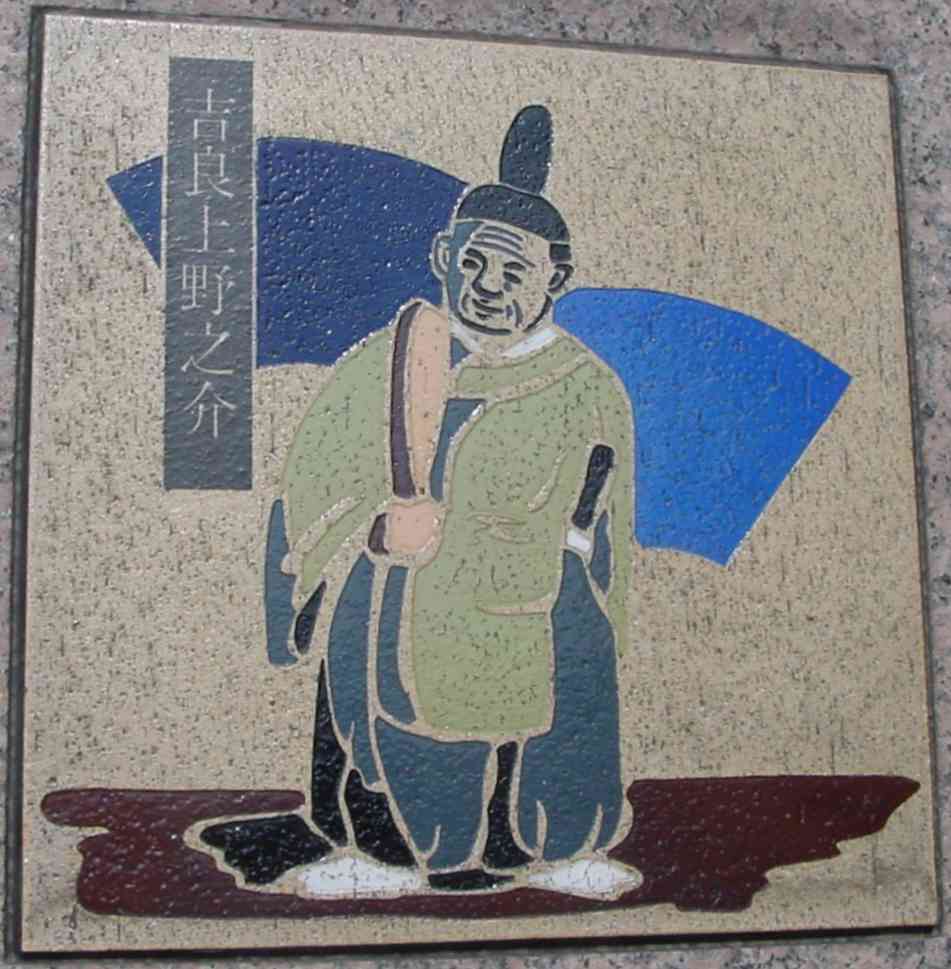
Also on "Basha-dori" street,this classic figure marks the street. I'll have the name in a moment. For some reason, my street is very well marked by various iconography. |

Enoshima center. Motif: The noble pine tree, looking more like wide-eyedmushrooms with hats, don't you think? |

Asakusa. The crowds in the street for the summer shrine toss Omikoshi matsuri. |
Japanese News of the Weird |
"CVN73" U.S. Navy creates manga about nuclear carrier " U.S. Naval Forces Japan headquarters has produced a Japanese language manga comic depicting the life of a U.S. serviceman of Japanese origin working as a crew member on the nuclear-powered aircraft carrier USS George Washington, which will be deployed to the U.S. naval base in Yokosuka, Kanagawa Prefecture in August 2008. The comic is about 200 pages long, and is titled "CVN73," after the number assigned to the carrier. It follows the life of a young man who grows up to be a strapping serviceman. (Yomiuri Shimbun) |
|
|
